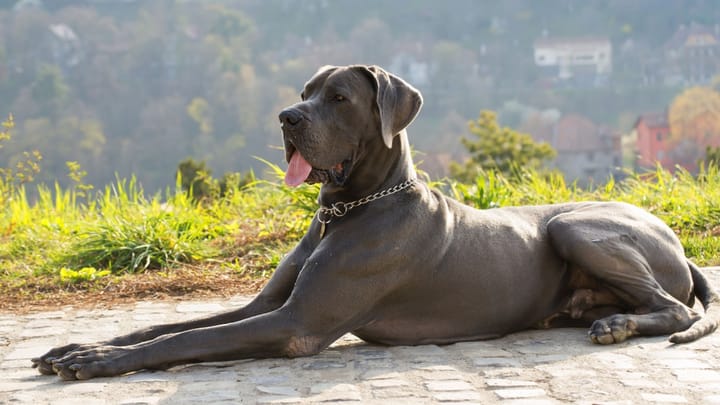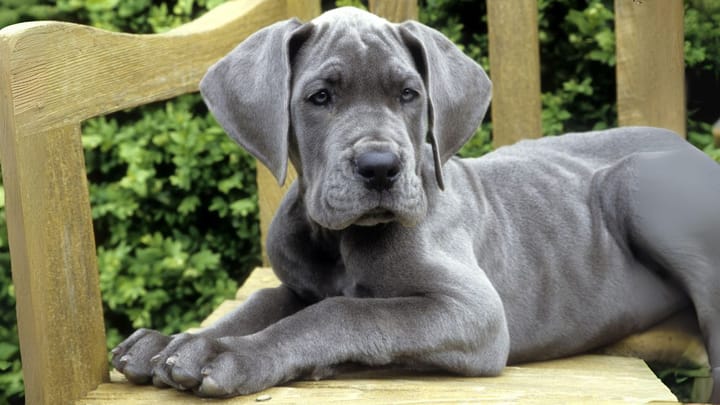Great Dane
Other names : Danish, Deutsche Dogge, German Mastiff


The Great Dane is the biggest dog in the world. It is difficult to go unnoticed by his side. His appearance is noble and his body is powerful. He is considered to be the Apollo of his species, as his presence and stature are remarkable. What’s more, his dedication to his family is proportional to his immense size. Very friendly among familiar faces, and especially with children, he remains suspicious of strangers. A very good watchdog, he is courageous and naturally dissuades with his mere presence.
|
Life expectancy |
The Great Dane has a life expectancy of between 8 and 10 years |
|
Temperament |
|
|
Size |
Large
|
|
Adult size |
Female
Between 28 and 33 in
Male
Between 31 and 35 in
|
|
Adult weight |
Female
Between 99 and 154 lb
Male
Between 110 and 154 lb
|
|
Coat colour
There are five coat colours:
|
Black White Blue Red |
|
Type of coat
The hair is short. The coat is dense, smooth and shiny; it should not be dull. This big dog has no undercoat. |
Very short |
|
Eye colour
The eyes must be as dark as possible. Clear, haggard or amber eyes are undesirable and not recognized by the standard of the breed. |
Brown
|
|
Purchase price |
The Great Dane costs between £830 and £1000 |
The biggest dog in the world was a Great Dane called Zeus. Unfortunately, he died at the age of 5 in 2014. He measured nearly 44 inches, which is more than 110 cm at the tourniquet. When he stood on his hind legs, Zeus could reach the height of 7 feet and 4 inches, which is to say, more than 2,10m.
More details about the Great Dane
Great Dane: Origins and history
The Great Dane is of German origin. Its ancestors were the ancient "Bullenbeisser" (Bull catchers), who came from the Saupacker (sow-catcher) breed in the middle-ages. They were all big game dogs hunting for deer, wild boar and bear. Their build was midway between the powerful English-type Great Dane and the Greyhound. However, until the First World War, this breed was called "Great Dane" because it was widespread in Denmark. In 1920, the name "German Mastiff" was adopted to remind that among the Great Dane’s ancestors were the massive fighting dogs of the Alains, an ancient nomadic people of Iranian descent, who came to Germany.
Physical characteristics of the Great Dane
The Great Dane is a proud dog with a powerful and elegant look. Since it is the world's biggest dog, it has a sturdy and well-built body. His appearance is noble and his proportions are balanced. There is strong sexual dimorphism between males and females.
Great Dane: Characteristics
Great Dane: Behaviour
Training a Great Dane
The Great Dane is a docile and obedient dog if the education he receives is both firm, gentle, and coherent. He will absolutely not accept physical or even psychological violence.
This dog will never be stubborn but can quickly capitulate if he feels any animosity on behalf of his master.
His education will need to be initiated from an early age to guarantee the safety of all once this giant dog has reached his adult size and weight.
Proper walking on a leash should be particularly prioritized and any type of elevation must be banned.
You should use positive reinforcement training, while maintaining a certain degree of firmness and consistency in the various learning processes in order to achieve the desired results.
Great Dane: Lifestyle
Breed compatibility Great Dane
Great Dane: Purchase price
The price of a Great Dane varies according to his origins, age and gender. An average of £1000 is to be paid for a dog registered with the Kennel Club.
The monthly budget for a mastiff is estimated at £80/month. It is quite consistent and ultimately proportional to the large size of this dog.
Great Dane: Shedding
Average
Hair loss is moderate but will be more consistent in spring and autumn, during moulting periods.
Great Dane: Grooming
This Danish dog’s maintenance is very easy but still deserves regular attention.
Brushing will have to be done weekly. Your Great Dane will appreciate it because he loves being taken care of.
Eyes and ears should be monitored and treated regularly as well.
Great Dane: Health
Life expectancy is estimated at 9 years.
Unfortunately, the large size of this dog does not make it perfectly healthy. He is rather sensitive, so he has a rather short life expectancy.
Heat can be tolerated, but he does not appreciate it much. Fresh and regularly renewed water will be indispensable and a cool place to rest should be made available.
Watch out for Harlequin Mastiffs who could quickly get sunburned if exposed too long outside.
Given the absence of a quality undercoat, cold tolerance is very limited for this large dog. So don't let him stay out in the winter or when it rains.
A Great Dane puppy’s diet should be closely monitored. Your dog’s food should not be too rich nor too nutrient-deficient. Daily rations must be adapted to the physical condition of the dog and his state of health. Avoid any excess.
- Joint and ligament problems: hip and elbow dysplasia
- Bloating-stomach twist syndrome
- Cardiomyopathy
- Entropy/Ectropion
- Rapid growth that can lead to skeletal development disorders
- Panosteitis (inflammation of the bones)
- Hyperparathyroidism (Bone weakness)
- Wobbler Syndrome (malformation of the cervical vertebrae)
- Osteochondritis (thickening and cracking of cartilage)
- Osteoarthritis






